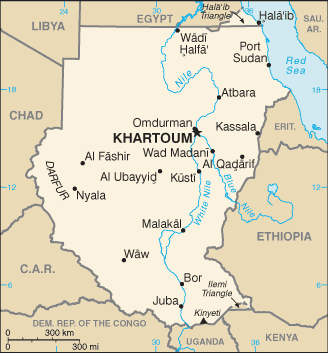|
Sudan
|

|
Capital: Khartoum
Population: 42,813,238
Brief History of Sudan:
The land of the Sudan has been inhabited by people for thousands of years. The first great empire to emerge was the Kushites. In the 8th century BC, Kush grew in strength and even took control over Egypt. This lasted until 590 BC when the Egyptian army sacked the Kush capital city, Napata, and caused the Kushites to move to Meroe and establish the Meroitic Kingdom which lasted until the 4th century AD.
Sudan became a group of small, independent kingdoms until 1820 when Egypt conquered the northern part of the country. In 1881 a religious leader came into power named Muhammad ibn Abdalla. His followers were called the Ansars, which means followers. Abdalla led a revolt in 1885.
Sudan became an independent country in 1956. A civil war immediately began between the southern areas and the Islamic government. It lasted for 17 years and then started up again in 1983. During the second civil war it's estimated that over two million people died. In 2011, South Sudan seceded from Sudan and became an independent country.
The Geography of Sudan
Total Size: 2,505,810 square km
Size Comparison: slightly more than one-quarter the size of the US
Geographical Coordinates: 15 00 N, 30 00 E
World Region or Continent: Africa
General Terrain: generally flat, featureless plain; mountains in far south, northeast and west; desert dominates the north
Geographical Low Point: Red Sea 0 m
Geographical High Point: Kinyeti 3,187 m
Climate: tropical in south; arid desert in north; rainy season varies by region (April to November)
Major cities: KHARTOUM (capital) 5.021 million (2009)
The People of Sudan
Type of Government: Government of National Unity (GNU) - the National Congress Party (NCP) and Sudan People's Liberation Movement (SPLM) formed a power-sharing government under the 2005 Comprehensive Peace Agreement (CPA); the NCP, which came to power by military coup in 1989, is the majority partner; the agreement stipulates national elections for the 2008 - 2009 timeframe.
Languages Spoken: Arabic (official), Nubian, Ta Bedawie, diverse dialects of Nilotic, Nilo-Hamitic, Sudanic languages, English
Independence: 1 January 1956 (from Egypt and UK)
National Holiday: Independence Day, 1 January (1956)
Nationality: Sudanese (singular and plural)
Religions: Sunni Muslim 70% (in north), indigenous beliefs 25%, Christian 5% (mostly in south and Khartoum)
National Symbol: secretary bird
National Anthem or Song: Nahnu Djundulla Djundulwatan (We Are the Army of God and of Our Land)
Economy of Sudan
Major Industries: oil, cotton ginning, textiles, cement, edible oils, sugar, soap distilling, shoes, petroleum refining, pharmaceuticals, armaments, automobile/light truck assembly
Agricultural Products: cotton, groundnuts (peanuts), sorghum, millet, wheat, gum arabic, sugarcane, cassava (tapioca), mangos, papaya, bananas, sweet potatoes, sesame; sheep, livestock
Natural Resources: petroleum; small reserves of iron ore, copper, chromium ore, zinc, tungsten, mica, silver, gold, hydropower
Major Exports: oil and petroleum products; cotton, sesame, livestock, groundnuts, gum arabic, sugar
Major Imports: foodstuffs, manufactured goods, refinery and transport equipment, medicines and chemicals, textiles, wheat
Currency: Sudanese dinar (SDD)
National GDP: $89,160,000,000
** Source for population (2012 est.) and GDP (2011 est.) is CIA World Factbook.
Back to Geography Home Page
